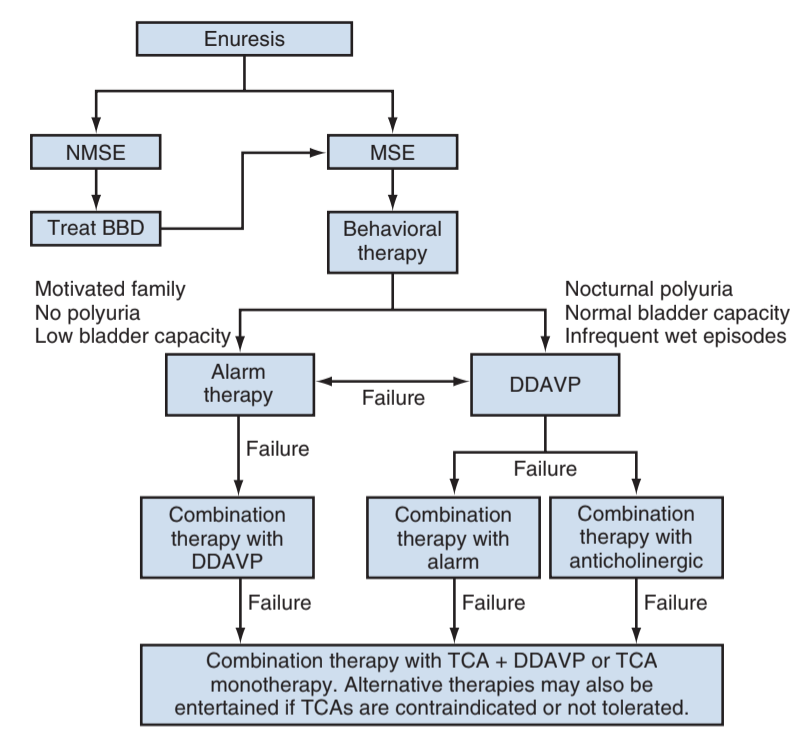Enuresis
Enuresis
Definitions
- Primary monosymptomatic enuresis: Nocturnal incontinence, in absence of other LUTS, without a prior period of nocturnal dryness
- Secondary monosymptomatic enuresis: Nocturnal incontinence, in absence of other LUTS, with a prior period of noctural dryness (6+ months)
- Non-monosymptomatic enuresis: Noctunral incontinence, with other LUTS present
General Treatment Tips
- The child must be willing/able to participate in treatment otherwise it will not succeed
- Void before bed, avoid fluids before bed
- Do not punish for enuresis (counterproductive)
- Assess family history (may be genetic component)
- May benefit from sleep study if frequent snoring
Enuresis alarm
- Best for motivated families, children with low PVR and without polyuria
- When alarm triggered, the child has to change bedding, reset alarm (active participation)
- Continue until at least 14 consecutive dry nights
- If no improvement after at least 6 weeks, unlikely to improve
- Discontinuation: 30%, skin irritation, bothersome to rest of family, or failure
Desmopressin
- Most effective in nocturnal polyuria (> 130% expected bladder capacity for age) and normal bladder function (max voided volume > 70% expected capacity for age)
- Dosing: 0.2mg 1hr before bedtime, titrate up by 0.2mg to max dose 0.6mg at bedtime
- Reassess within 2 weeks to determine whether improvement present
- Consider using only for certain occasions vs nightly
- Drug holiday for 1 week every 3-6 months to assess whether still warranted
TCAs
- Considered third line therapy
- Dosing: 10-25mg imipramine 1hr before bed, can titrate up by 25mg after 1 week, usual dose 25mg (5-8yo) and 50mg (9+yo), do not exceed 50mg (6-12yo) and 75mg (13+yo)
- Reassess efficacy at 1mo, if no improvement after 3mo then discontinue with taper
- Drug holiday q3-6mo to assess continued need, tapering dose over 2 weeks
- Side effects: less than 5% overall, but can increase suicidal ideations and cardiac complications (risk with overdosing) - obtain personal/family cardiac history
References
- AUA Core Curriculum`
- Austin, P. and A. Seth. "Functional Disorders of the Lower Urinary Tract in Children." Campbell-Walsh Urology 12 (2020).
- Baskin, Laurence S. Handbook of pediatric urology. Lippincott Williams & Wilkins, 2018.
- Wilcox, D. and K. Rove. "Clinical and Urodynamic Evaluation of Lower Urinary Tract Dysfunction in Children." Campbell-Walsh Urology 12 (2020).
